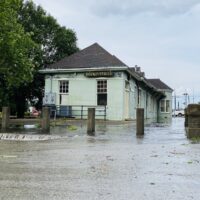Two paths covering nearly 7,000 acres of Land Between the Lakes National Recreation Area were carved up by December’s tornado outbreak, leaving portions of LBL in both Kentucky and Tennessee heavily damaged after the storm.
LBL officials say about 4% of the recreation area was heavily impacted. They estimate around 3,200 acres were damaged in the north end near Lyon County, Kentucky, and about 3,500 were damaged in the south end in Stewart County, Tennessee. These calculations don’t include areas with lighter impact from the storms.
Now that LBL officials understand the scale and scope of the damage, Public Affairs Specialist Carlin Lewis says they can move forward, though recovery for the forested areas will take time.
“This was such a large-scale event and caused so much damage and impacted areas that it’ll take years to recover,” Lewis said. “The forests, like our communities, are resilient and the work we’re doing is helping the forest recover over time.”
Public safety, Lewis added, has been first priority since the storm hit. In the immediate aftermath, LBL sent out forrester crews to survey areas for damage and possibly prepare some areas for salvage. The groups removed debris from high-use recreation areas, rerouted trails and cleared roads.
None of the recreation area’s structures were damaged but some trails are still closed or temporarily rerouted and a day-use area still needs to be cleared before it can be reopened for public use. Visitors can check for closures on LBL’s alerts page.
Anyone who goes to LBL will be able to see first-hand the force of the disaster by looking at the trees twisted and torn down by the tornadoes, specifically in the oak and hickory forests in the damaged areas. To help these areas recover, officials aim to remove some of the damaged timber to limit the potential for insect infestations and wildfire outbreaks and also to improve the resiliency of the forest.
“Opening the forest canopy and letting the forest floor receive more sunlight will encourage natural regeneration of plants and promote the early successional growth like native grasses and forbs, and wildflowers,” Lewis said. “Then other benefits of the work include increased public safety … as well as providing marketable timber and forest products for the local economy.”
The process is focused on the moderate and catastrophic damage in the impacted areas, and the foresters won’t be clear-cutting, Lewis said. Not every downed or damaged tree will be removed during this process.
“When we’re done with these cleanup efforts and the salvage sales, it will not look like a pristine golf course,” Lewis said. “There will still be remnants of damaged trees, as the salvage operation will be picking up bigger diameter trees that were fairly or catastrophically impacted and those bigger diameter trees that are on the ground.”
Some of these damaged trees will be sold for timber to a variety of groups. Not only will this provide the local economy with a boost, Lewis said, it should improve the environment.
“Harvesting some of these dead and damaged trees, we will maximize the value of the forest resource, which provides benefits to our local communities, as well as offsets the cost that these recovery efforts can incur to ultimately return these lands to healthy, thriving forests,” she said.
The timber sales will be taken on by a variety of timber contractors and groups like saw mills, pulp mills, lumber yards and wood processors. Some will be turned into cross ties or veneer.
This story is republished with permission from WKMS. Read the original.
Lily Burris is a features reporter for WKMS. She has a bachelor's degree in journalism from Western Kentucky University. She has written for the College Heights Herald at WKU, interned with Louisville Public Media, served as a tornado recovery reporter with WKMS and most recently worked as a journalist with the Kentucky Center for Investigative Reporting. In her free time, she enjoys reading, crocheting and baking.





